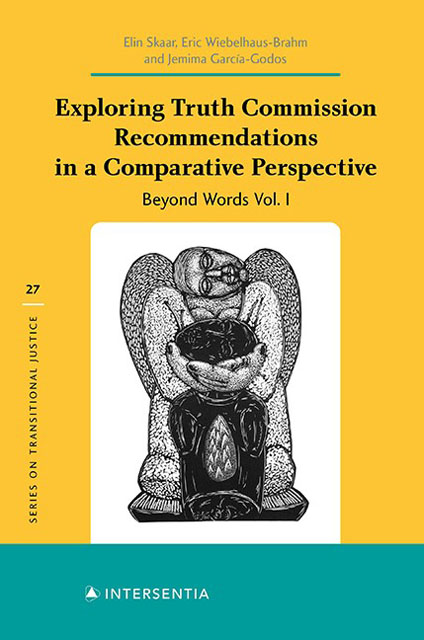Book contents
- Frontmatter
- Preface
- Contents
- List of Acronyms and Abbreviations
- List of Tables and Figures
- Chapter 1 Exploring Recommendations
- Chapter 2 Researching Recommendations
- Chapter 3 Counting and Classifying Recommendations
- Chapter 4 Formulating Recommendations
- Chapter 5 Case Studies of Implementation
- Chapter 6 A Cross-National Analysis of Implementation
- Chapter 7 Conclusions
- Appendix I Latin American truth Commission Reports
- Appendix II Information on 13 Latin American truth CommissionReports and their Recommendations
- Appendix III Excerpts from the truth Commission Recommendations Data Code Book
- Appendix IV Implementation of the Recommendations Made by 13 Latin American truth Commissions
- Appendix V Implementation Rates for Recommendations Made by 13 Latin American truth Commissions, by Category
- Appendix VI Overview of Commissioners of 12 Formal Latin American truth Commissions
- Appendix VII Latin American Countries Signatories to and Ratification of the International Convention for the Protection of All Persons from Enforced Disappearance (2006)
- Bibliography
- Index
- About the Authors
Chapter 4 - Formulating Recommendations
Published online by Cambridge University Press: 19 November 2022
- Frontmatter
- Preface
- Contents
- List of Acronyms and Abbreviations
- List of Tables and Figures
- Chapter 1 Exploring Recommendations
- Chapter 2 Researching Recommendations
- Chapter 3 Counting and Classifying Recommendations
- Chapter 4 Formulating Recommendations
- Chapter 5 Case Studies of Implementation
- Chapter 6 A Cross-National Analysis of Implementation
- Chapter 7 Conclusions
- Appendix I Latin American truth Commission Reports
- Appendix II Information on 13 Latin American truth CommissionReports and their Recommendations
- Appendix III Excerpts from the truth Commission Recommendations Data Code Book
- Appendix IV Implementation of the Recommendations Made by 13 Latin American truth Commissions
- Appendix V Implementation Rates for Recommendations Made by 13 Latin American truth Commissions, by Category
- Appendix VI Overview of Commissioners of 12 Formal Latin American truth Commissions
- Appendix VII Latin American Countries Signatories to and Ratification of the International Convention for the Protection of All Persons from Enforced Disappearance (2006)
- Bibliography
- Index
- About the Authors
Summary
A poor idea well written is more likely to be accepted than a good idea poorly written.
– Isaac Asimov, scientist and writer (1920 – 1992)Why do truth commissions give the recommendations that they do? This is not merely a rhetorical question. truth commission reports are written documents. We can thus think of them as pure text. We can also think of them as policy documents. As we know, the dual aim of a truth commission is to document a specified set of human rights violations committed over a particular period of time, frequently by identifying alleged perpetrators (often institutions responsible such as the military, state agents, paramilitaries, etc.), and to provide recommendations to the government for follow-up action after the commission's work has been completed. The information documented by truth commissions is more often than not very contentious. One should not expect their recommendations to be any less controversial.
The aim of this chapter is to explore the processes through which the sets of recommendations presented in the final versions of truth commission reports are formulated. By the formulation process , we refer to all of the actions that contribute to the development of the recommendations presented by truth commissions. This begins with the identification of ideas to be included and the needs to be met, followed by the design and methods to be applied. Then, commissions deliberate and select the measures to be included. Finally, the recommendations are drafted. Formulation does not happen in a vacuum. To varying degrees, recommendations are shaped by drafters’ interactions (or lack thereof) with actors outside the commission.
In this chapter, we analyze recommendations both as textual and contextual items. Why are recommendations formulated the way they are? Who decided what is to be recommended and on what grounds? Do recommendations express realistic goals or revolutionary dreams? Whether we read recommendations as concrete suggestions for action to be taken by the governments to which the truth commission reports are handed, or as expressions of hope for a better future, there is a normative element present in the formulation process of all recommendations. The raison d‘être of recommendations is to suggest alternative ways of doing things in order to achieve various forms of justice and ultimately promote nunca más, never again.
Information
- Type
- Chapter
- Information
- Exploring Truth Commission Recommendations in a Comparative Perspective: Beyond Words Vol 1 , pp. 93 - 112Publisher: IntersentiaPrint publication year: 2022
